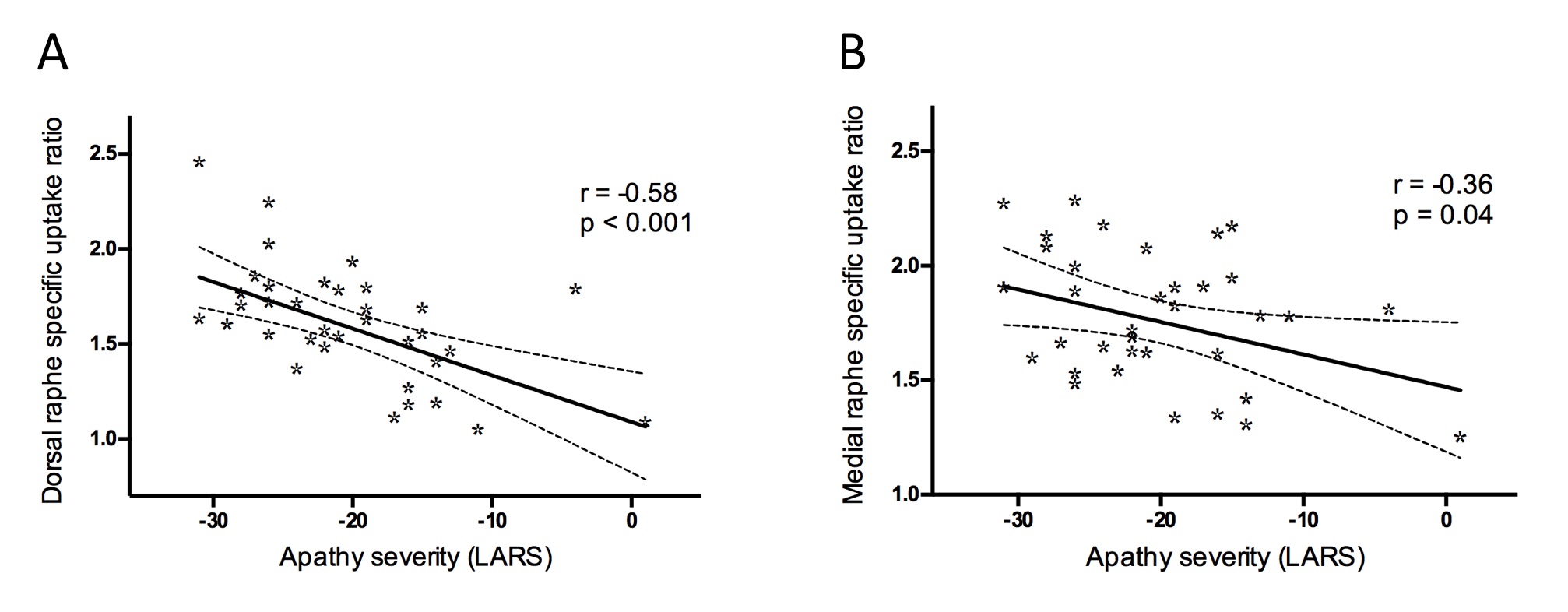Session Information
Date: Monday, October 8, 2018
Session Title: Parkinson's Disease: Psychiatric Manifestations
Session Time: 1:15pm-2:45pm
Location: Hall 3FG
Objective: To investigate whether apathy is related to serotonin depletion in the raphe nuclei in patients with rapid eye movement sleep behaviour disorder (RBD), a population representing the prodromal phase of Parkinson’s Disease.
Background: Apathy is a common and under-recognised disorder that often emerges in the prodromal phase of Parkinson’s disease (PD). Recent evidence suggests that dysfunction in serotonergic systems may have a role in the pathogenesis of apathy in established PD, with important implications for potential treatment strategies. Whether this mechanism occurs during prodromal disease is not known.
Methods: Thirty-five patients with idiopathic RBD underwent assessment. The mean age was 65.4 years (SD 7.51) and 34/35 were male. RBD was diagnosed by polysomnography according to recognised criteria, and was not secondary to medication or an established neurological disorder. Apathy was quantified using the Lille Apathy Rating Scale (LARS). Depression, anxiety, cognition and other clinical features were assessed using standard rating scales. All participants underwent brain imaging with 123I-ioflupane single photon emission computed tomography (SPECT/CT). Serotonin transporter level can be measured using 123I-ioflupane in brain regions lacking dopamine transporters, since the compound binds non-specifically to both types of monoaminergic transporter. Structural MRI was obtained for registration purposes. Raphe nuclei regions of interest from the Harvard Ascending Arousal Network Atlas were used.
Results: Eighteen patients (51%) were classed as apathetic according to LARS scores. In other clinical measures, apathetic patients were not more impaired than non-apathetic patients. Negative correlations were observed between apathy severity and 123I-ioflupane SPECT/CT signal in the dorsal raphe nucleus (r = -0.58, p < 0.001), and median raphe nucleus (r = -0.36, p = 0.04), respectively [figure 1]. There was no significant correlation between apathy severity and dopaminergic signal in the basal ganglia, nor between dorsal raphe signal and other neuropsychiatric scores.
Conclusions: Apathy in RBD patients is associated with reduced serotonin level in the dorsal raphe nucleus. This relationship is dissociable from dopaminergic degeneration and other neuropsychiatric disorders, suggesting that the serotonergic system might represent a specific target for the treatment of apathy.
To cite this abstract in AMA style:
T. Barber, L. Griffanti, K. Muhammed, D. Drew, K. Bradley, D. McGowan, M. Crabbe, C. Lo, C. Mackay, M. Husain, M. Hu, J. Klein. Apathy in rapid eye movement sleep behaviour disorder is associated with serotonin depletion in the raphe nuclei [abstract]. Mov Disord. 2018; 33 (suppl 2). https://www.mdsabstracts.org/abstract/apathy-in-rapid-eye-movement-sleep-behaviour-disorder-is-associated-with-serotonin-depletion-in-the-raphe-nuclei/. Accessed December 4, 2025.« Back to 2018 International Congress
MDS Abstracts - https://www.mdsabstracts.org/abstract/apathy-in-rapid-eye-movement-sleep-behaviour-disorder-is-associated-with-serotonin-depletion-in-the-raphe-nuclei/

